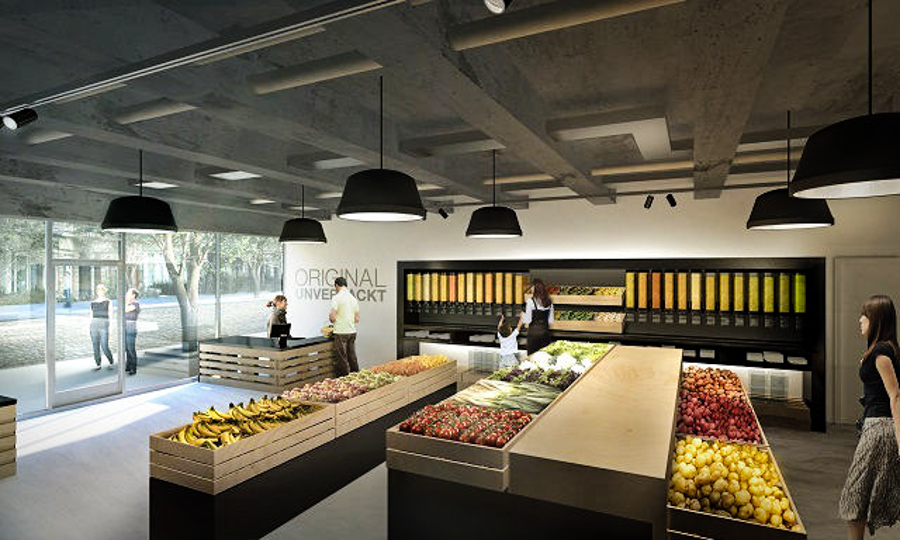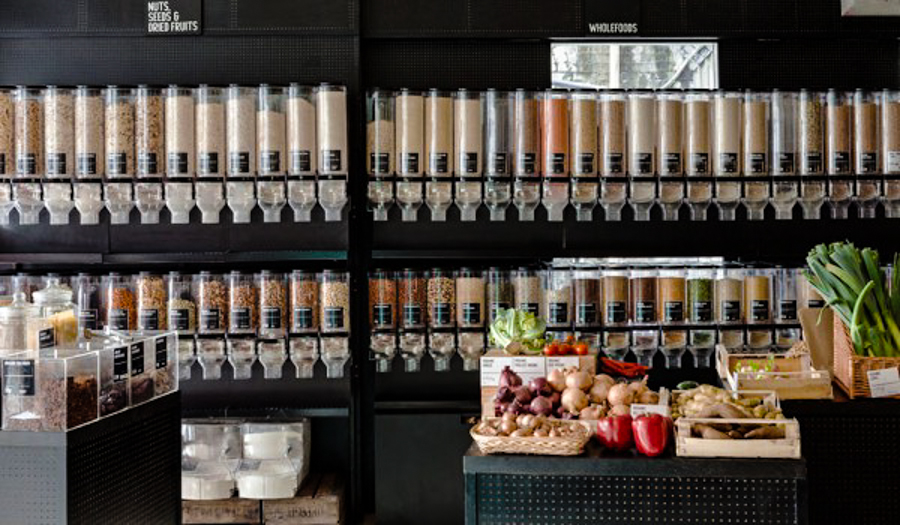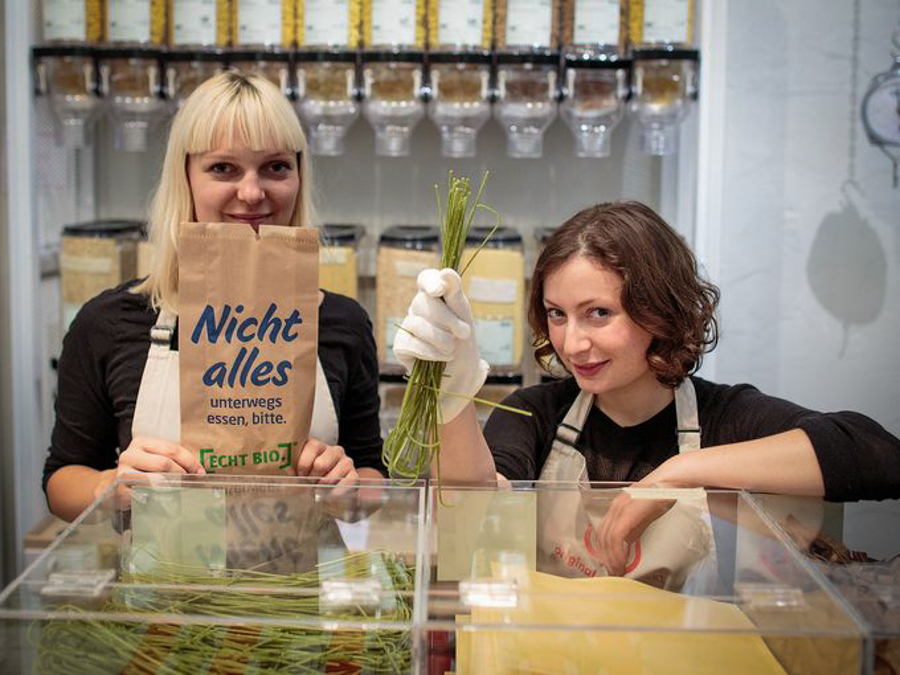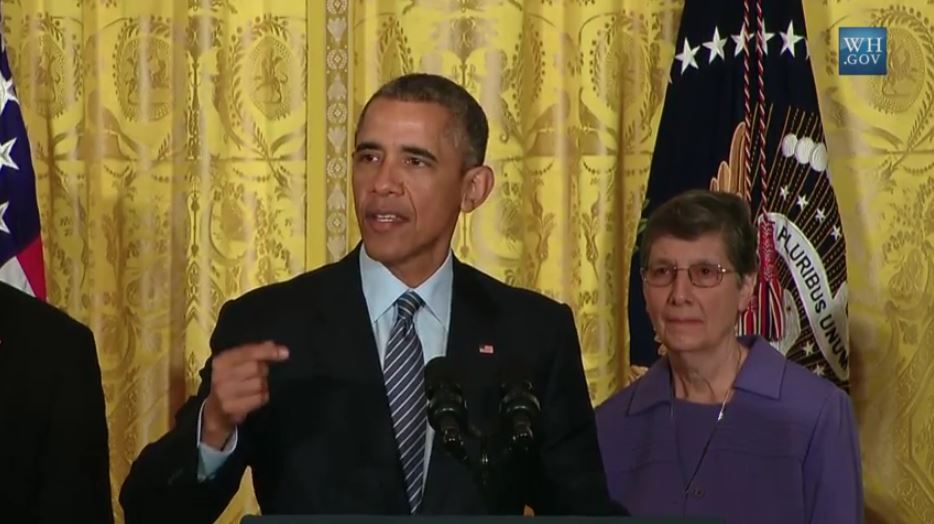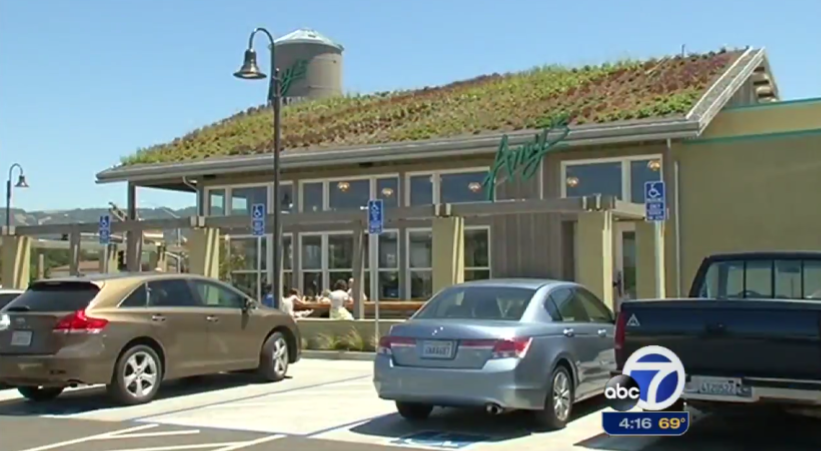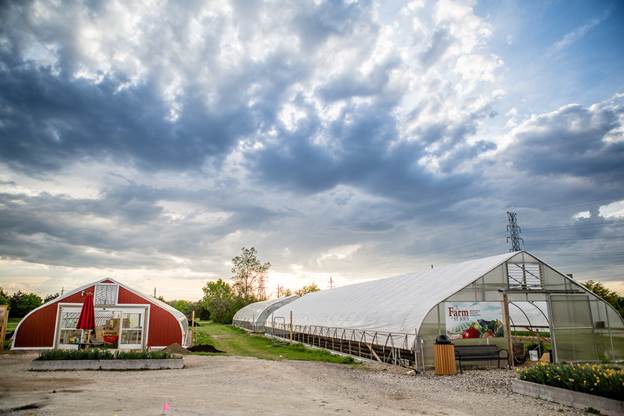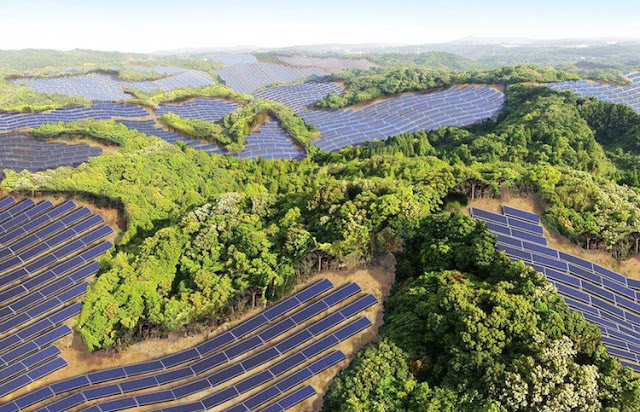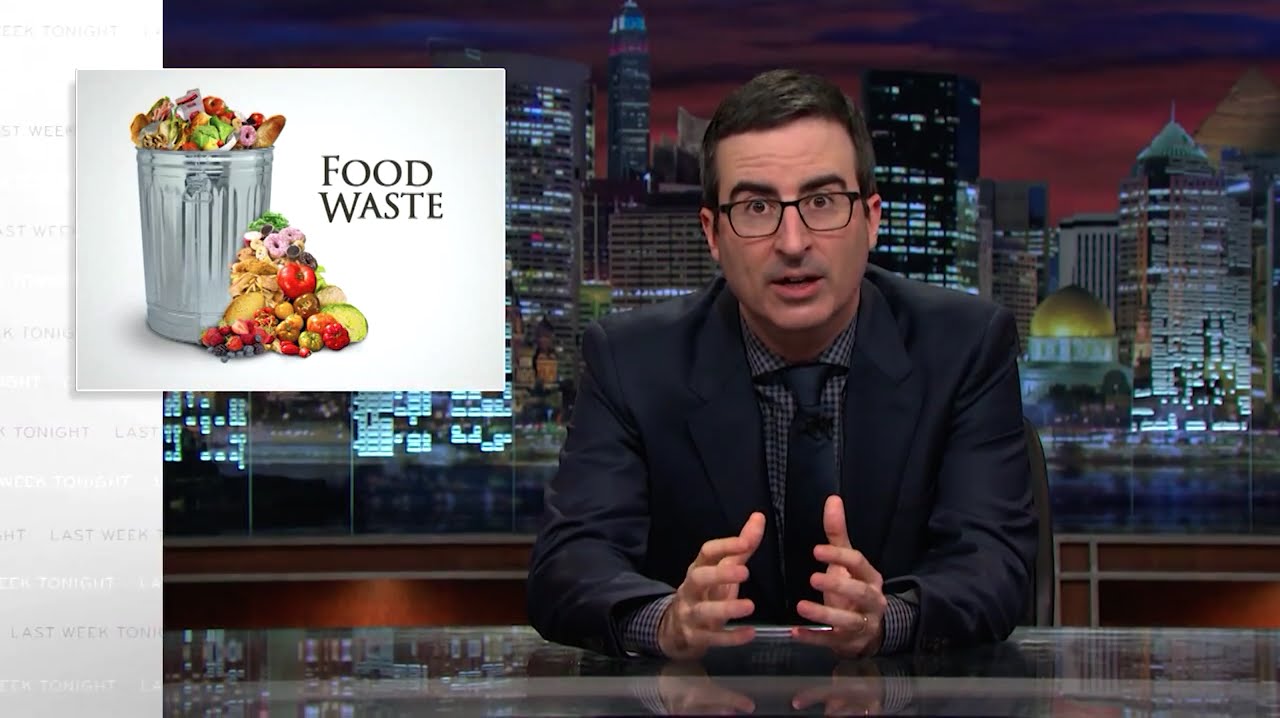This zero-waste grocery store has no packaging, plastic or big-name brands
Forget Whole Foods.
The Original Unverpackt is the first Zero Waste Grocery store in the World.
The idea came to be when founders Sara Wolf and Milena Glimbovski were determined to create “something impossible.” They used crowd funding to back the store and decided to challenge the traditional shopping experience. The store’s mission is to stop contributing to waste that’s caused by food packaging by selling groceries in a sustainable manner (16 million tonnes per year in Germany alone).
Three studies conducted in 2013 found that 12 million tonnes of food waste is accumulated annually amounting to a price tag of £19 billion a year. This figure isn’t only swelling landfills, but also contributes to 20 million tonnes of the nation’s greenhouse gas emissions annually.
Sara Wolf and Milena Glimbovski are the creators of Original Unverpackt
The same study states that 75% of this waste could have been easily sidestepped with more efficient infrastructure.
In terms of pricing, some of the products offered at Original Unverpackt are more expensive, mainly because they’re organic. But other items are comparable, if not cheaper than standard supermarkets. The “fill-your-own-container” idea can save customers money by preventing them from overspending on food. Customers can bring their own containers, such as tubs and recycled bags-which are also sold at the store-and pay based on the weight of the products.
Although many believe that the sustainable supermarket model is unlikely to reach North America anytime soon, awareness and demand for low-waste alternatives will undoubtedly speed up the process.
A customer shops at the Original Unverpackt store in Berlin
Sources: torontoist.com, wordpress.com, gannett-cdn.com, timesofoman.com
Obama Reveals His Most Ambitious Plan To Tackle Climate Change
by
CREDIT: White House video screenshot
The Environmental Protection Agency released its long-awaited final rule to regulate carbon pollution from existing power plants on Monday afternoon. This is the most significant action any American president has ever taken to rein in climate change.
Addressing a crowd of scientists in the East Room of the White House, President Obama ticked through a list of threats that confronted the world since he took office: economic calamity, terrorism, nuclear weapons.
“But I am convinced that no challenge poses a greater threat to our future and future generations than a changing climate,” he said. “I believe there is such a thing as being too late. That shouldn’t make us hopeless. It’s not as if there’s nothing we can do about it. We can take action.”
Existing power plants will no longer be able to pollute unlimited amounts of carbon dioxide into the air in the United States once the plan takes effect, which will be 60 days following the as-yet determined date the plan is published in the Federal Register.
The coal, oil, and gas burned in most of these plants is responsible for nearly 40 percent of all carbon pollution in the United States. The Clean Power Plan sets the first-ever federal limits on the main pollutant that causes climate change.
“We now have a real shot of protecting this beautiful planet of ours,” EPA Administrator Gina McCarthy said before she introduced President Obama at Monday’s event. McCarthy summed up her agency’s approach in this video from the EPA:
The final rule’s national emissions targets were what had been expected. “Nationwide, by 2030, this final CAA section 111(d) existing source rule will achieve CO2 emission reductions from the utility power sector of approximately 32 percent from CO2 emission levels in 2005,” the rule stated. These reductions will result in $25-45 billion in net climate and health benefits by 2030, according to the agency’s analysis.
Obama also explained the plan at Monday’s event: each state will be able to come up with its own plan to cut emissions in a way that works for them. By 2030, each state must meet a certain emissions reduction target, custom-tailored to their current energy mix. The EPA does not implement a top-down solution across the country to cut emissions, or force specific coal plants to close.
“We’ll reward states that take actions sooner, rather than later, because time is not on our side,” Obama said.
Every state can meet its targets however it wants – closing old coal plants, building more renewable generation, increasing energy efficiency, or working with other states to balance emissions and cuts through market-based systems like the cap-and-trade model already being used by the RGGI states in the Northeast.
Since many states are already regulating carbon pollution, the president said that this federal action was just Washington catching up to that leadership demonstrated by the rest of the country.
Compared to the proposed rule, the new final version cuts more carbon pollution from the power sector, does it with more renewable energy and less natural gas, while providing more flexibility along the way to states trying to meet their targets.
The solar and energy efficiency industries lauded the rule. The wind power industry said it’s up to the task to help states comply.
“American wind power can do this,” Tom Kiernan, CEO of the American Wind Energy Association, said in a statement. “Low-cost wind energy reduced carbon emissions by five percent in 2014, and we’re capable of doing a lot more.”
Obama ticked through several of the criticisms the plan had received, including on electricity rates, coal jobs, and government overreach. He received a standing ovation for this passage about the plan’s impact on minority and low-income communities:
Even more cynical, we’ve got critics of this plan who are actually claiming that this will harm minority and low-income communities. Even though climate change hurts those Americans the most, who are the most vulnerable. Today, an African American child is more than twice as likely to be hospitalized from asthma. A Latino child is 40 percent more likely to die from asthma. So if you care about low income and minority communities, start protecting the air that they breathe and stop trying to rob them of their health care.
Carbon dioxide released from power plants traps heat and pollutants in the air, and so air quality diminishes. This helps to trigger asthma and heart attacks. The EPA says up to 90,000 asthma attacks will be avoided each year under the rule.
Later, the president went off script, saying “sometimes we feel as if there’s nothing we can do.”
“Tomorrow’s my birthday,” he said, and began to reflect on his younger college days. He said he arrived in Los Angeles in 1979 for college and wanted to go outside and take a run. But after five minutes, he couldn’t breathe, because of the horrible smog problem it faced. He listed other environmental calamities, such as Ohio’s Cuyahoga River being so polluted that it caught on fire.
Even with those horrible problems, he said, the nation came together to fix them. California’s air is much cleaner, as are Ohio’s waterways. The parallel to climate change was clear.
“We can figure this stuff out as long as we’re not lazy about it,” he said.
These rules are not the result of new congressional legislation. They are the result of what the Clean Air Act tells the executive branch it has to do.
When Congress passed, and President George H.W. Bush signed, the 1990 update to the Clean Air Act, it included a section on pollutants not specified or envisioned by lawmakers at the time. In 2007, the Supreme Court decided in Mass. v. EPA that carbon dioxide qualified as a pollutant that could be regulated under that section of the Clean Air Act if the EPA found it to be a danger to public health. In 2009, the EPA found exactly that, and so the Obama administration began regulating sources of carbon dioxide. It started with mobile sources of carbon pollution, and so the administration set greenhouse gas emission standards for cars, trucks, and heavy-duty vehicles. The Clean Power Plan is just the next step in regulating carbon pollution as required by the Clean Air Act. Monday’s announcement will set the EPA, working with the states, to regulating power plant carbon pollution.
The EPA also released its final rule for new, modified, and reconstructed power plants. Unlike the rule for existing plants, this rule sets a specific limit on coal-fired plants: 1,400 pounds of CO2 per megawatt‐hour, which is less-stringent than the proposed rule’s standard of 1,100 pounds of CO2 per megawatt‐hour. This change was made, after feedback the EPA received about the cost of implementing a carbon capture and sequestration system.
“I don’t want to fool you, this will be hard,” the president said in his Monday speech. “We’re the first generation to feel the impact of climate change, we’re the last generation that can do something about it. We only get one home. We only get one planet. There’s no Plan B.”
As the speech concluded, Obama got emotional, his voice softening. “I don’t want my grandkids not to be able to swim in Hawaii or not to be able to climb a mountain and see a glacier because we didn’t do something about it. I don’t want millions of people’s lives disrupted and this world more dangerous because we didn’t so something about it. That’d be shameful of us.”
“This is our moment to get this right and leave something better for our kids,” he said. “Let’s make the most of this opportunity.”
The event was supposed to be held outside on the White House South Lawn, but was moved inside due to high heat and humidity. Monday was the 11th straight day that cracked 90 in Washington, D.C.
Lines Out the Door for Nation’s First Organic Drive-Thru Restaurant

Think fast food has to be greasy, unhealthy and cheap? Think again.
The country’s first all-organic drive-thru has finally opened in California, with lines out the door as customers flock for a chance to support what could be the biggest step forward for industry ever.
The new Amy’s Organic Drive-Thru restaurant opened in Rohnert Park, California, featuring an all-vegeterian menu packed with items like veggie burgers, salads, and even mac n’ cheese in both regular and vegan flavors.
The company’s signature frozen pizzas have always been a top seller in health food and grocery stores nationwide, and now Amy’s first restaurant is serving them up piping hot with toppings ranging from spinach and diced tomatoes (on its popular margherita pizza) to regular mozzarella cheese and even vegan “cheeze.”
As reported by ABC-7 News in the Bay area, the new Amy’s Restaurant has been completely packed with long lines in the dining area and in the drive-thru, and reported wait times of 15-20 minutes.
Others have chimed in on review sites noting that they were excited to see huge crowds with lines going all the way out the door, reminiscent of another chain working to change the food system: Chipotle Mexican Grill, whose popularity is exploding at the same time that McDonald’s is faltering.
“Five days in and they can barely keep up with demand,” reported ABC-7 about Amy’s first week in business.
Manager Paul Schiefer was more than happy with the response.
“So many (have) showed up and it’s given us a lot of hope that this is a concept that works.”
Sustainably Grown, GMO-Free and Tasty!
While other fast food restaurants import virtually all of their products from factory farming operations and give nothing back to the community, Amy’s actually grows produce on site thanks to its roof-bound garden.
Amy’s, an independently owned organic frozen food company, also reportedly pays workers a living wage with health benefits and is believed to be the first vegetarian fast food restaurant as well.
Check out a report on the grand opening below and see the menu:
Are Hospital Farms the Next Big Thing in Healthcare Reform?

This summer, St. Luke’s Hospital started sending all new moms home from the hospital with a basket of fresh produce, recipes and literature about the importance of a healthy diet.
All of the produce in the basket was grown on an organic farm on the hospital’s Anderson campus in Bethlehem, Pennsylvania. The hospital-part of a six-campus network-has been running a farm on the 500-acre grounds since 2014.
“Our mission is to provide great healthcare and part of that is educating patients about the benefits of a plant-based, organic diet,” explains Ed Nawrocki, president of the Anderson campus. “One of the best ways to do that is to lead by example and show them how delicious produce grown on our farm tastes.
But it’s not just new moms who benefit from the hospital’s bounty. In its first season, the farm at St. Luke’s grew 12 varieties of vegetables on five acres, producing 44,000 pounds of produce that was served to patients, incorporated into the cafeteria menu, and sold at weekly farmers markets on several hospital campuses. This year, the farm expanded to 10 acres and 30 varieties of fruits and vegetables.
Mark “Coach” Smallwood, executive director at the Rodale Institute, the nonprofit organization that worked with St. Luke’s to help get its farm off the ground, believes there is a growing interest in serving organic, locally grown produce at hospitals.
Some, like the University of Wisconsin Hospital, buy produce from local farms, others allow the community to use land on their campuses for community gardens. Now, a few hospitals are taking the next step, starting farms on hospital campuses. Among them are Stony Brook University Hospital on Long Island and Watertown Regional Medical Center in Wisconsin. Both are now using produce grown onsite to replace fruits and vegetables that are packaged and shipped thousands of miles before reaching patients.
“Hippocrates talked about food as medicine and we believe that to be true,” Smallwood says. “There is a paradigm shift happening and hospitals are realizing the value of producing fresh, local, organic food to serve to their patients.”
St. Joseph Mercy Ann Arbor Hospital in Ypsilanti, Michigan, planted the first crops on a 10-acre onsite farm in 2010 after patient satisfaction surveys revealed a demand. Over the past five years, the farm has grown to 25 acres, three hoop houses and four beehives. The farm grows fresh spinach, garlic, basil, collard greens and strawberries.
“The farm helps us support a culture of wellness in the hospital,” says director of nutrition and wellness Lisa McDowell. “We can’t grow enough to meet the needs of all of our patients and staff, but we can make an educational statement about the importance of eating a healthy diet.”
While farm-to-hospital efforts have been well received by patients and created PR opportunities, operating a hospital-run farm is not without its challenges.
For starters, administrators are experts in healthcare, not agriculture.
To help launch its farm, St. Luke’s partnered with the Rodale Institute for assistance in creating and implementing a plan, hiring a farmer, and managing operations. At St. Joseph Mercy, the hospital invested $32,000 in two hoop houses, hired a full-time farmer to manage farming operations for the 537-bed hospital and relies on interns and volunteers to handle most of the labor.
It took a $125,000 capital investment to start the farm at St. Luke’s and, after two growing seasons, the farm is operating at a loss (with a goal of breaking even in 2016). The reason: Growing organic produce on the farm is more expensive than purchasing it through a foodservice supplier or sourcing it from local farms. But Nawrocki still champions the idea, explaining that encouraging patients to eat healthier diets now could improve their health in the future.
In addition to the capital investment to start farms, hospitals that want to serve fresh produce must invest in recipe development and training foodservice workers to transition from heating and reheating prepared foods to making dishes from scratch.
“When we order produce from a food service provider, it comes peeled and chopped and portioned; all our staff has to do is open the package and add it to the recipe,” McDowell explains. “Cooking with fresh foods from our farm is much more labor intense.”
In the future, the hospital hopes to partner with a local culinary program, using interns to offset the additional labor costs and make its hospital farm cost neutral by 2020.
Smallwood admits that foodservice staff is often resistant to the changes, which create additional work; hospitals that contract with external foodservice providers face the additional obstacle of needing to get buy-in.
“A paradigm shift has to occur,” he says. “Outsourcing is easier; over time, we believe that hospital-based farms can be as easy as outsourcing.”
It’s not just the behind-the-scenes issues that can stymie efforts to grow and serve fresh produce. Convincing patients to trade comfort foods like mac and cheese for whipped turnips and sautéed spinach can also be challenging.
“Some people just don’t care,” Nawrocki admits.
But, with the help of robust marketing campaigns and creative efforts, some hospitals are determined to help patients rethink their diets. St. Luke’s reduced prices at the salad bar by 25 percent to promote the farm’s produce; cafeteria sales are up 15 percent and, earlier this month, farmers markets at all six campuses sold out of produce.
“It takes creativity and flexibility to make [a hospital-based farm] work,” Nawrocki says. “But we believe it’s the right thing to do and that drives our efforts.”
This is Tesla’s plan for a cheaper car
Many companies are already planning concepts around the promise of cheaper, higher-capacity batteries. But, it turns out that Tesla has more than one path toward its ultimate goal of an electric car that’s 50% cheaper than its luxury Model S.
The newest direction Tesla is headed toward is silicon-not the Valley, but the material that is changing the way batteries are made. Tesla’s new 90 kilowatt-hour battery pack -an upgrade announced Friday that increases pack energy by 5% and adds about 15 miles of range to its vehicles-might look the same. But the inclusion of silicon is an advance for lithium-ion technology.
During a call with reporters last week, CEO Elon Musk said the company had improved the battery by shifting the cell chemistry for the pack to partially use silicon in the anode.
“This is just sort of a baby step in the direction of using silicon in the anode,” Musk said during the call. “We’re still primarily using synthetic graphite, but over time we’ll be increasing silicon in the anode.”
For the unfamiliar, this might sound like minor tinkering. It’s actually an important and challenging step for Tesla (and other battery manufacturers) that could lead to a better, cheaper battery.
“It’s a race among the battery makers to get more and more silicon in,” said Jeff Dahn, a leading lithium-ion battery researcher and professor at Dalhousie University in Nova Scotia who recently signed a 5-year exclusive partnership with Tesla. “The number of researchers around the world working on silicon for lithium-ion cells is mindboggling. A large number of academics and industrial folks are working really hard on this problem.”
Batteries 101
A battery contains two electrodes: an anode (negative) on one side and a cathode (positive) on the other. An electrolyte, essentially the courier that moves ions between the electrodes when charging and discharging, sits in the middle.
Graphite is commonly used as the anode in commercial lithium-ion batteries. However, a silicon anode can store about 10 times more (per unit volume) lithium ions. In theory, if you replaced a lot of graphite in the cell with silicon, the thickness of the graphite negative electrode could be reduced. There would be more space to add more active material and you could, in turn, increase the energy density-or the amount of energy that can be stored in a battery per its volume-of the cell.
In other words, you could pack more energy in the same space. Plus, the silicon used in the battery space doesn’t need to be the same quality as what’s used in solar cells and integrated circuits, which means it’s cheaper. The more silicon you put in the battery, the easier it is to drive costs down.
That’s the goal of battery makers everywhere: to improve their product while reducing costs.
Sounds easy enough, right? Hardly, says Dahn, who is currently working on a project funded by 3M and the Natural Sciences and Engineering Research Council of Canada to develop longer lasting, lower cost lithium-ion battery cells. Their exclusive partnership with Tesla will begin in June 2016, once Dahn has completed the 3M research project.
The trick is that when you add lithium to the silicon you end up with almost five times the original number of atoms you started with. And that causes all kinds of problems.
An Electrode Particle Walks Into a Party
Think of the battery electrode as a room and a lot of electrode particles-or people- are packed in there for a party, Dahn explains. Now imagine that everybody in that room suddenly becomes obese; the people aren’t going to fit anymore.
“If everyone is already packed in there and they all become 400 pounds, you’re in big trouble,” says Dahn.
This is what happens when all the particles in the electrode are silicon. But if only a few people in the room become obese, it’s not so bad because they can shuffle around and make enough space for these obese folks.
“This is why only a small amount of silicon is being initially added,” Dahn says.
That’s not the only issue with using silicon. To take the crowded room analogy a step further, imagine these obese people (or electrode particles) shrink when the battery is charged and then blow up again when it’s discharged. That enormous volume change causes another issue. The surface of every silicon particle is in contact with the electrolyte, and the protective film on the silicon is continually being stretched as the size of those particles change. When it shrinks it can flake off, which can impact the lifespan of the battery.
This means that the more silicon you put in, the more challenging it is to maintain cycle life, Dahn says.
Which brings us to where battery makers and researchers are today.
“Right now, you put in a touch-a little pixie dust-and it’s tolerable,” says Dahn. “Over the years, more and more will go in and that’s a good thing because it means these products are going to improve and get better.”
Dahn’s research team aims to increase both the energy density and the lifespan of lithium-ion cells, which could, in turn, help drive down costs in automotive and grid energy storage applications. They aren’t the only ones. “There are quite a few companies around the world that are starting to put silicon in the negative electrode,” explains Dahn. “And it’s not just Panasonic, Tesla’s supplier. Samsung and other companies around the world are doing this too.”
Most batteries today, even those in consumer electronics, have tiny amounts of silicon, says Sam Jaffe, a longtime analyst, formerly of Navigant Research, and now CEO of startup Cygnus Energy Storage.
The question is what percentage of silicon is Tesla using. The industry standard is between 1 to 3% silicon in battery recipes, Jaffe says. He believes Tesla has figured out how to use more.
“For them to have made a significant change in the energy density of the battery and then to publicly say it’s the silicon increase makes me think-and this is speculation now-that they’ve made progress getting higher percentages of silicon into the cell,” Jaffe says.
Model X and Tesla as a Supplier
“There’s a lot of incentive to continue to improve this battery technology for everyone in the industry,” Karl Brauer, a senior analyst at Kelley Blue Book, told Fortune. “It’s certainly the lifeblood for Tesla.”
Tesla had to increase the battery capacity for the highly anticipated Model X SUV because it’s heavier and without it, the vehicle would have lost range, Brauer says.
Brauer also believes the focus on battery tech isn’t just to improve the cars, but to set the company up as a supplier.
With many companies already anticipating the use of cheaper, more powerful lithium-ion batteries and competing to apply that technology to residential and commercial power grid applications, Tesla’s move could put them at the forefront of a newly revolutionized energy industry.
Host Country Of Upcoming Climate Summit Passes Energy And Climate Overhaul
On Wednesday, France, host to the major United Nations conference on climate change at the end of the year, passed a law that both re-envisions the country’s energy system and sets an impressive precedent for the leadership potential France could offer come December.
The long-anticipated law will halve the country’s energy consumption by 2050, cut nuclear power production by a third by 2025 (from 75 percent of electricity mix to 50 percent), and increase renewable energy to 32 percent of total energy consumption by 2030. It also requires France to reduce carbon emissions by 40 percent by 2030 compared with 1990 levels, in part by reducing fossil fuel consumption by 30 percent in 2030 compared with 2012. The emissions reduction requirement is in line with the E.U.’s 28-country commitment to cut emissions at least 40 percent by 2030.
That’s a lot to keep track of. As part of the effort, the French parliament will have to produce “carbon budgets” every five years, which will help set emissions targets for different parts of the economy. Large emitters will face a more stringent carbon tax that could nearly quadruple by 2020 from its current rate of 14.50 euros ($15.93) per metric ton.
France introduced its domestic carbon tax in 2014 to cover companies not regulated by the E.U. Emissions Trading Scheme (ETS), including those consuming natural gas, heating oil, and coal. The tax later expanded to fuels including gasoline and diesel. Originally, it started at 7 ($7.69) euros/metric ton.
As the Carbon Pulse reports, “only around five percent of France’s power comes from fossil fuels, so the tax increase will have little bearing on electricity prices. However, the country relies on natural gas and fuel oil for much of its domestic heating, meaning the higher tax will raise some household bills while adding an estimated 7 cents to a litre of gasoline and 9 cents to a litre of diesel by 2022.”
While the fossil fuel, greenhouse gas emissions, and renewable energy targets likely stand out to the international community, the rapid curtailment of nuclear power is probably the most substantial, and controversial, domestic element of the law. France is the second biggest nuclear energy producer in the world, and the country that relies most on it for electricity, with 58 reactors at 19 different power stations. In his 2012 campaign, French President Francois Hollande promised to cut back the country’s reliance on nuclear power. The new law effectively means that some of the older nuclear plants will close in the next couple years to meet the 63.2 gigawatts production limit to be put in place.
The exact manner in which these cuts will be implemented is yet to be fully agreed upon, which had led to some pushback from environmental groups like Greenpeace.
“This law sets goals, which is interesting, but it doesn’t explain how to reach them,” Greenpeace energy campaigner Yannick Rousselet told Reuters.
While the reduction in nuclear power will also cost some jobs – the industry employs an estimated 220,000 people – French Environment Minister Segolene Royal said the reforms will create 100,000 new jobs in the green sector in the next three years.
“It’s the most advanced law of its kind among industrial countries,” Royal said in an interview with French media.
President Hollande has even bigger achievements on his mind when it comes to climate change. On Tuesday at the “Summit of Conscience for the Climate” in Paris, Hollande said “an agreement must be found” at the Paris U.N. climate summit in order to avert climate crisis.
“Today, with the agreement we see taking shape, we are still above two degrees Celsius, and probably three,” said Hollande. A viable deal needs to forsake “the use of 80 percent of fossil-based energy resources to which we still have easy access,” according to Hollande.
Across the channel on Wednesday, the British government made a controversial move in seemingly the opposite direction of France by announcing plans to curb subsidies for renewable forms of energy like small solar projects and biomass generators. The plan comes weeks after the newly re-elected Liberal Prime Minister David Cameron’s government said it would also discontinue onshore wind farm subsidies next year.
“We can’t have a situation where industry has a blank cheque and that cheque is paid for by people’s bills,” said energy secretary Amber Rudd.
In responding to the cuts, the U.K.-based Guardian newspaper stated in an editorial that “it is true that some of the incentives have been too successful,” but that “just like fracking and nuclear, greening the energy supply needs intervention. It will not be cheap. But for future generations, not doing it will cost far more.”
Aspiring Chinese architect built his office out of 8,500 recycled beer bottles
“Beer is proof that God loves us and wants us to be happy.” This quote erroneously credited to Benjamin Franklin is nonetheless apt and resonant with drinkers around the world. The world’s most popular alcoholic drink and third most popular drink (after tea and water), beer is a gift that keeps on giving. And when it’s all finished, the empty bottles can be used for an assortment of projects. Aspiring architect Li Rongjun has taken beer to a new level by building the second floor of his office with 8,500 recycled bottles.
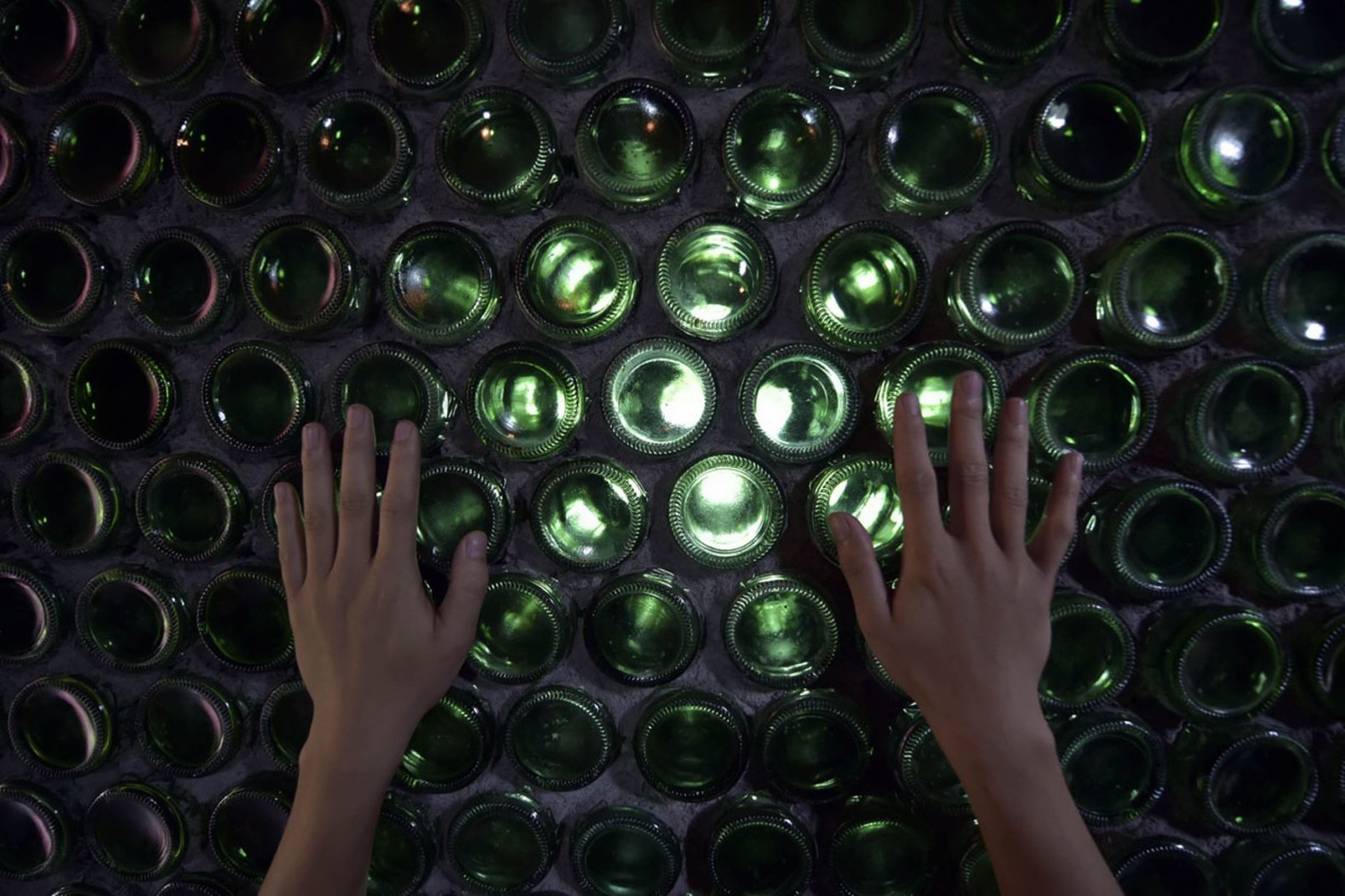

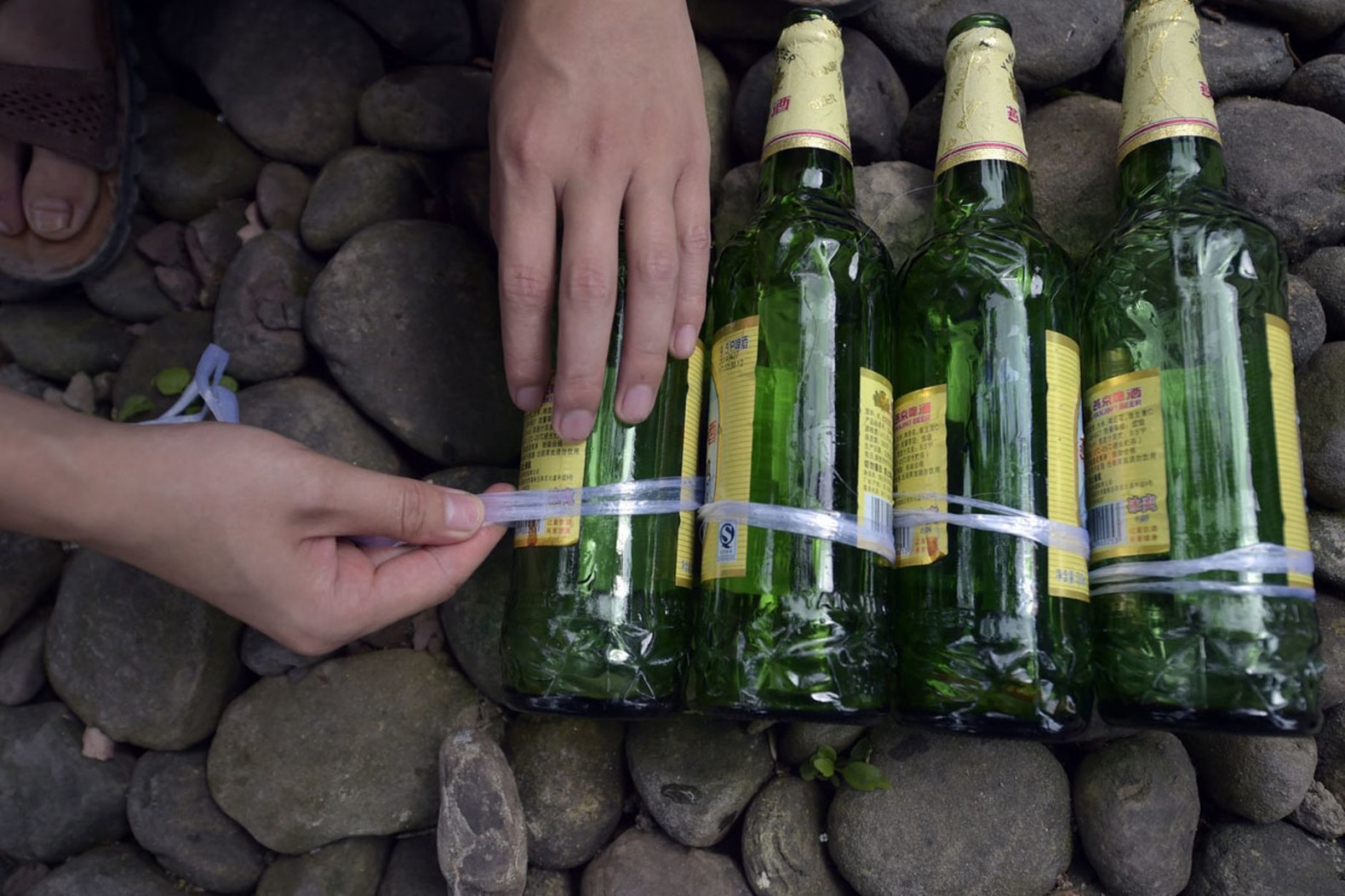
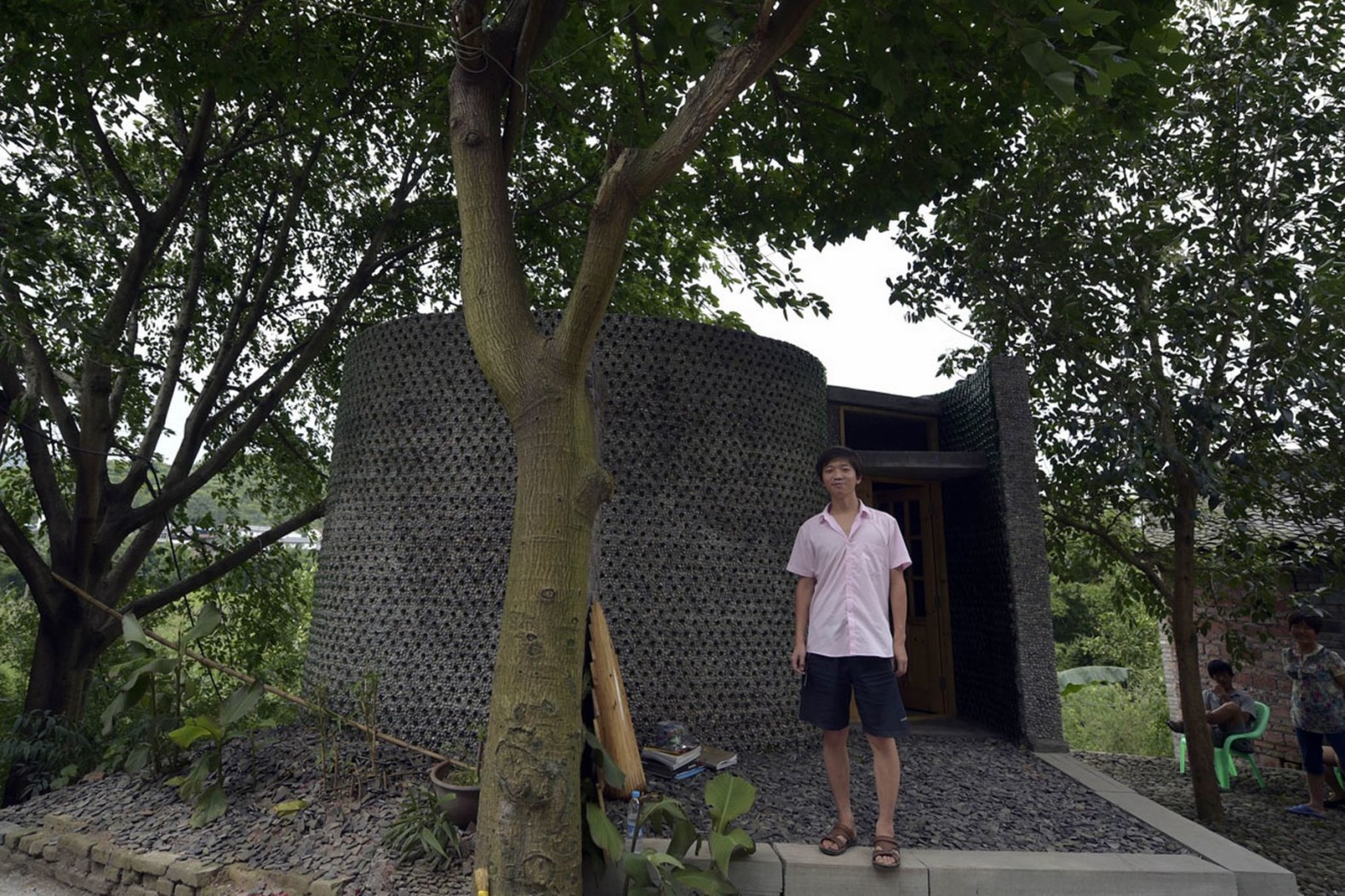



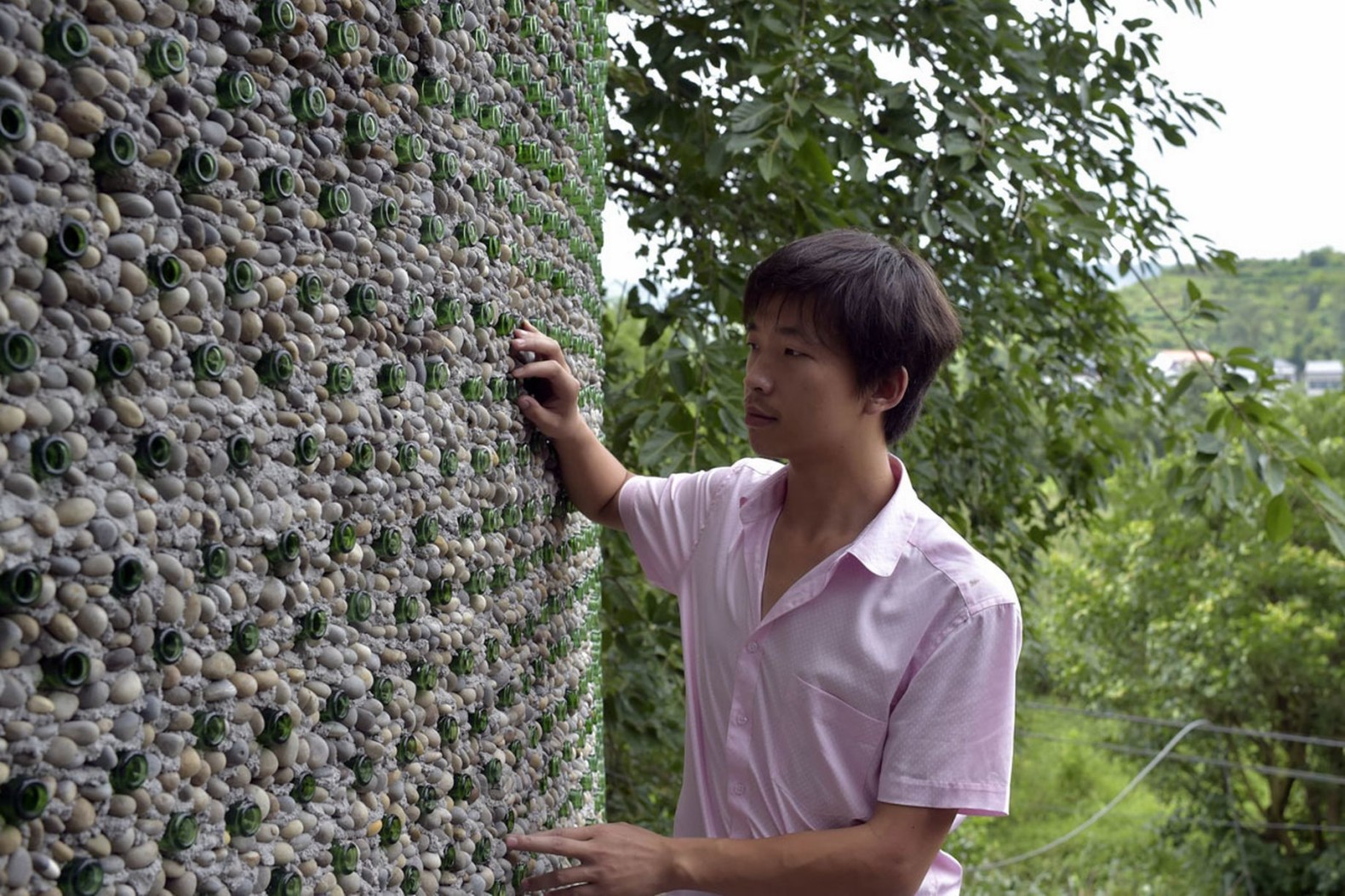
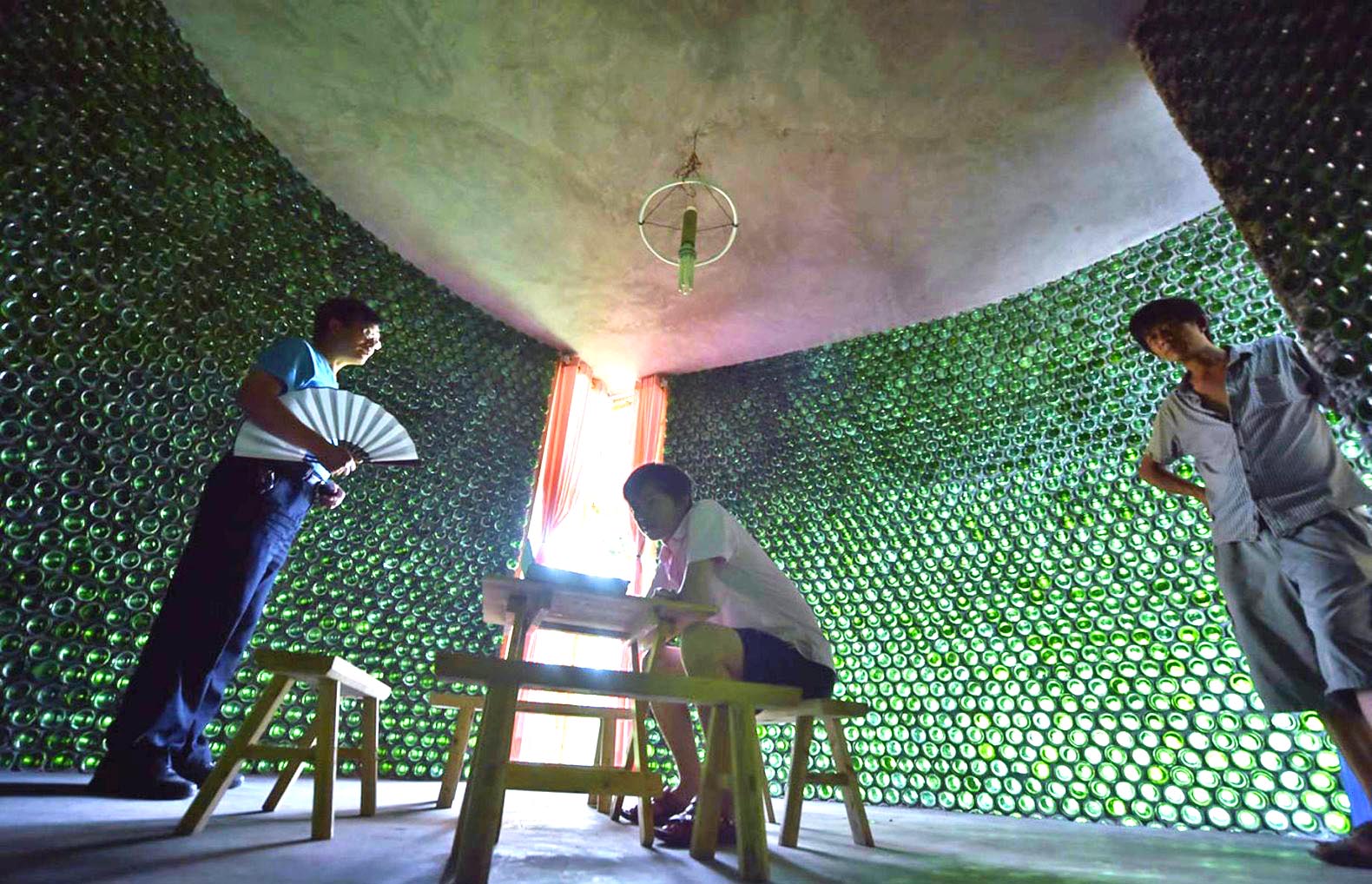
Li had previously worked for local construction companies but his dream of beer building was stifled in these settings. “There is no creativity and it’s a waste of life to be there,” Li says. “No matter if I succeed or not, I want to give my dream a try.” Li’s 300-square foot office serves as a practical and promotional purpose. “I wanted to build an artistic and usable office,” says Li. “This building is also my calling card for my future business plans. It will allow investors to see my products in real life and see my talent.”
Related: DIY: How to Recycle Aluminum Soda and Beer Cans into Roof Shingles and Siding
“He has been very independent from a young age. We could see that he has a strong determination to create his own business,” says Li’s father. “When he proposed to build the glass house, although we are a family of limited means I immediately told him he would have my complete support.” Li also seems to have support from his neighbors. “At night it looks even better,” says neighbor Li Yan. “The lights are on and the building glows. Some of the green light shines over to the nearby road.” One wonders if Li drank all of the beer by himself or if his family and friends also lent their support for this mission.
Via Oddity Central
Images via ChinaFotoPress/Getty
Marijuana Absorbs Nuclear Radiation
The many uses of the HEMP plant include much more than the relaxing euphoric feeling caused by THC. Paper, fuel, rope, plastic, and countless other uses have been identified.
However one of the attribute you may not have heard about is the cannabis plant’s ability to absorb nuclear radiation.
Marijuana was actually used in the cleaning up of Chernobyl, similar to the sunflower plants. Thus for the recent nuclear disaster in Japan, cultivation of marijuana is a viable alternative since this plant absorbs the radiation. It is also viable to other places with regards on the laws of the states and the country that is going to be planted.
The earthquake in Japan and the resulting nuclear power plant disaster at Fukushima has rocked the entire world with the threat and spread of nuclear waste contamination. The unknown amount of different hazardous chemicals has been released into the atmosphere and ocean that threaten our food chain for the long foreseeable future. Marijuana may be one of the alternative keys reducing this damage we all face.
The Daily Alternative Reports:
Many people know that the cannabis plant has amazing healing powers; however the same plant can literally “eat away” nuclear waste. From the flower’s ability to aid and keep people from going blind, to the woody core of the stem’s ability to build fire proof homes and much more. Now, we can add another use to the list: Marijuana as a tool to clean up nuclear contamination around Chernobyl.
Historically in 1998, the Consolidated Growers and Processors (CGP), Phytotech, and the Ukraine’s Institute of Bast Crops planted industrial marijuana to help remove contaminants in the soil near Chernobyl. Marijuana is one of the best plants for a process called phytoremediation that has been mentioned before. It is a term coined by Dr. Ilya Raskin of Rutgers University’s Biotechnology Center for Agriculture and the Environment. Dr. Raskin had been sent to examine food safety at the Chernobyl site.
Phytotech specializes in phytoremediation, the general term for using phyto (plants) to remediate (clean up) polluted sites. Phytoremediation has been used to remove radioactive elements from soil and water at former weapons producing areas. It can also be used to clean up metals, pesticides, solvents, explosives, crude oil, and toxins leaching from landfills. Plants break down or degrade organic pollutants and stabilize metal contaminants by acting as filters or traps. The U.S. Environmental Protection Agency (EPA) has estimated that more than 30,000 sites in the United States alone require hazardous waste treatment. Since nowadays there are so many pollutants and nuclear radiations everywhere on the entire earth and sea we might expect there are many more locations almost everywhere.
Founded in 1931, the Institute of Bast Crops is now the leading research institution in the Ukraine, working on seed breeding, seed growing, cultivating, harvesting and processing hemp (marijuana) and flax. The Bast Institute has a genetic bank that includes 400 varieties of hemp from various regions of the world. Newer technologies in hemp harvesting and processing are also being developed at the institute whose library contains more than 55,000 volumes mainly on hemp growing and flax growing. “Hemp is proving to be one of the best phyto-remediative plants we have been able to find,” said Slavik Dushenkov, a research scientist with Phytotech.
The company Phytotech lists the benefits of phytoremediation (compared to traditional remedial technologies):
Lower cost
Applicability to a broad range of metals
Potential for recycling the metal-rich biomass
Minimal environmental disturbance
Minimization of secondary air and waterborne wastes
Nobody knows how far the extension of the contamination from the nuclear power plant disaster at Fukushima because the tsunami and wind bring together the radioactivity almost everywhere on earth.Thus it is hard to think about the tons of nuclear contaminated water getting pumped into our mutually shared ocean and how it is going to broadly effect a great deal of our ecosystems.
Growing cannabis can improve the soil when it grown as a break crop i.e. to relieve and revitalize the soil between crops. Farmers are getting a 27% increased yield after the marijuana crop because industrial marijuana puts nitrogen back into the soil, suppress weeds and diseases, and clean contaminates out of the planet, then you would realize this plant is medicine for our Mother Earth.
Mutant Flowers From Japan’s Fukushima Nuclear Disaster Go Viral Online
Four years after the disaster at Japan’s Fukushima nuclear power plant, strange things still are happening to the plants and animals living there.
Recent years have brought reports of deformed fruit and mutant butterflies, but the latest is a remarkable photo of deformed daisies posted on Twitter by @san_kaido, who took the photo below in Nasushiobara City, which lies about 70 miles from Fukushima.
Translated from Japanese, @san_kaiod’s tweet describes how the daisies growing there have apparently been impacted by exposure to radiation since the March 2011 incident, which resulted in the meltdown of three of Fukushima’s six reactors following a devastating tsunami:
“The right one grew up, split into 2 stems to have 2 flowers connected each other, having 4 stems of flower tied beltlike,” according to Fukushima Diary. “The left one has 4 stems grew up to be tied to each other and it had the ring-shaped flower. The atmospheric dose is 0.5 μSv/h at 1m above the ground.”
マーガレットの帯化(那須塩原市5/26)②
右は4つの花茎が帯状に繋がったまま成長し,途中で2つに別れて2つの花がつながって咲いた。左は4つの花茎がそのまま成長して繋がって花が咲き輪の様になった。空間線量0.5μSv地点(地上高1m) pic.twitter.com/MinxdFgXBC
— 三悔堂 (@san_kaido) May 27, 2015
The last sentence from the tweet — about the radiation dose now being “0.5 μSv/h at 1m above the ground” — describes the radiation dose per hour that’s now present at the site where the photo above was taken. It’s classified as safe for “medium to long term habitation” according to this explanation of radiation levels.
That no doubt played a part in the Japanese government’s recent decision to allow more than 7,000 residents of a town near the Fukushima plant to return home, four years after being evacuated. As the London Telegraph learned, however, it’s unclear how many residents actually will go back to live there permanently.
“There are no shops. There are no doctors. I don’t know what to do,” one former resident told local Japanese media.
Japan’s Abandoned Golf Courses Are Being Transformed Into Solar Power Farms!
The Kyocera Corporation is transforming an abandoned golf course into a solar power farm, with ambition to partner and repeat the same sustainable work elsewhere in Japan.
Incredible news: An abandoned and bankrupt golf course is being transformed into a solar power station by the Kyocera Corporation.
Last week, the business announced it would turn the former golf course in Kyoto into a 23-megawatt solar farm; the artist’s rendition is shown above.
Once the solar power farm is finished and online (in 2017), it will generate enough electricity to power 8,100 homes.
But the Kyocera Corporation has no intention of stopping there: it aims to join with several other companies and build a second 92-megawatt solar plant on a golf course that was never completed in Kagoshima Prefecture.
As the Independent shares, there are plenty of golf courses than can be converted in the future. In the 1990’s, Japan experienced a sudden “golf boom,” and ended up constructing more than 2,000 new courses in just a few years. But since the fad has passed (some might say as quickly as it started), many golf courses have gone bankrupt and now hundreds exist – abandoned – across the countryside.
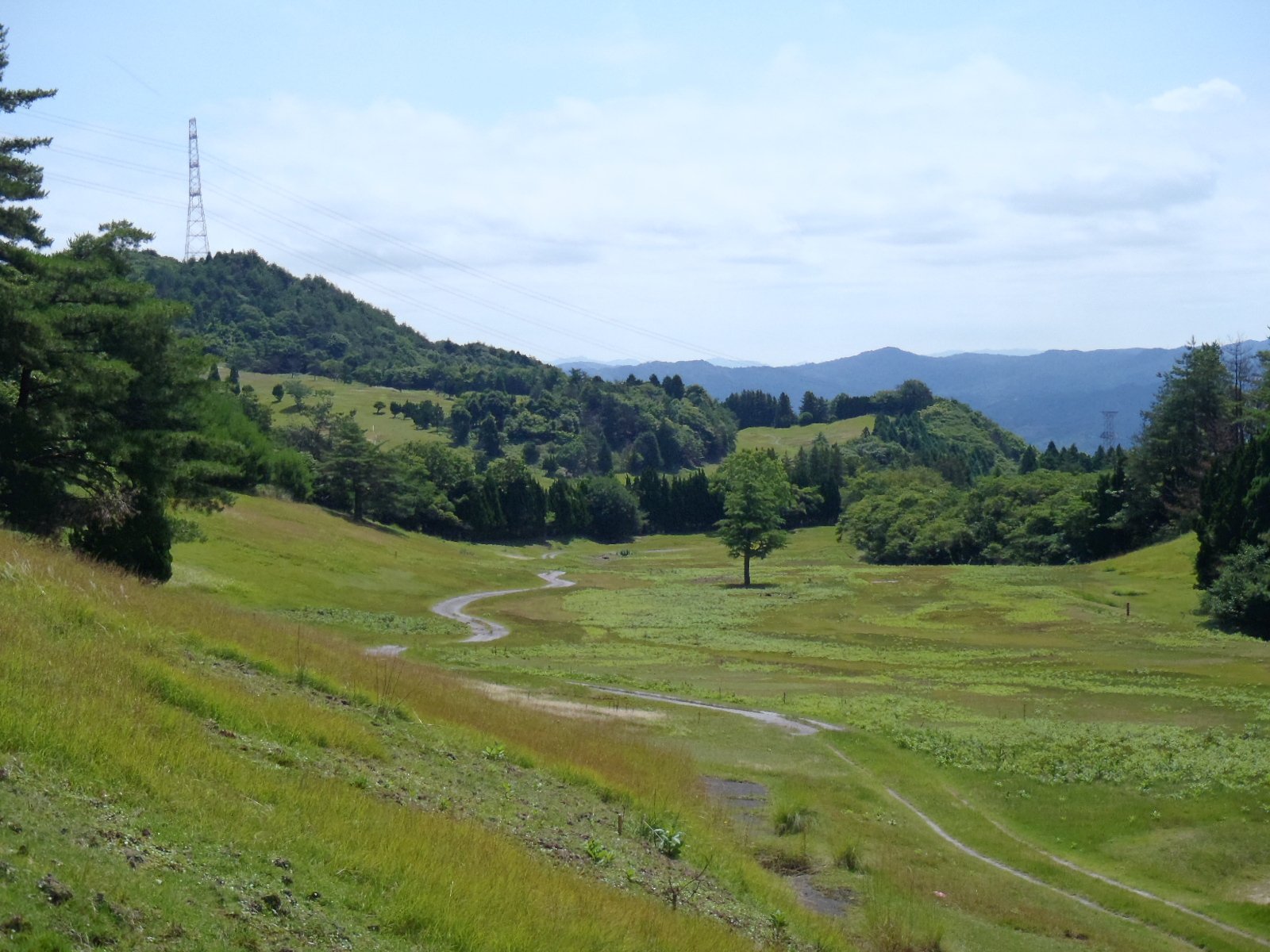
Thankfully, golf courses are the perfect place to build solar farms. The wide-open spaces receive plenty of sun making them prime real estate for the installation of solar panels.
Perhaps other countries will also follow suit with this innovative way of re-purposing abandoned golf courses. Because many courses shut down in the US during the 2008 recession, cities in Florida, Utah, Kansas, and Minnesota are discussing ideas for turning many of those into solar power stations as well. It seems the owners recognize the potential for selling to energy companies and are looking to put their abandoned courses to good use.
Share your thoughts on this new s in the comments section below!
The world is getting better all the time, in 11 maps and charts
by Zack Beauchamp on July 13, 2015
Reading the news, it sometimes feels like the world is falling apart: that everything is going to hell in a handbasket and we’re on the verge of a total collapse. In fact, we’re living through what is, by objective metrics, the best time in human history. People have never lived longer, better, safer, or richer lives than they do now. And these 11 charts and maps – which draw on centuries of data, as well as a brand new UN report that focuses on the past 25 years – prove it.
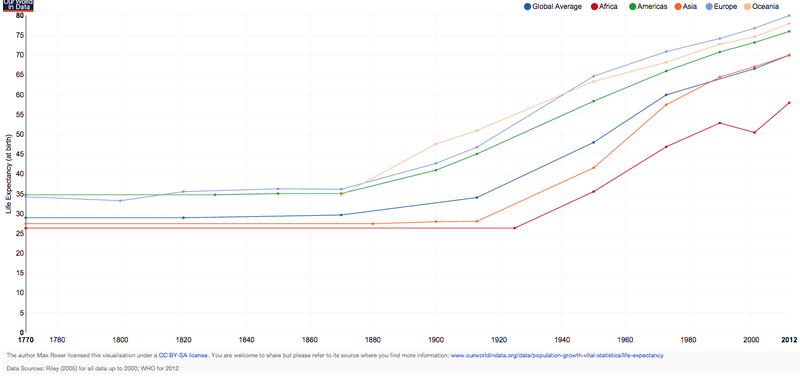
For most of human history, our lives were nasty, brutish, and pretty damn short. Only in the past 200 years or so, as this chart shows, have people started living lives that even come close to what we see as normal today. In 1770, the world’s average life expectancy was just 29 years old (a lot of people died really young). Today, it’s 70. That staggering jump represents the greatest accomplishment in human history: our victory over historical killers like disease, poverty, and war. Everything else in the post is, to a certain extent, an explanation of this one extraordinary fact.
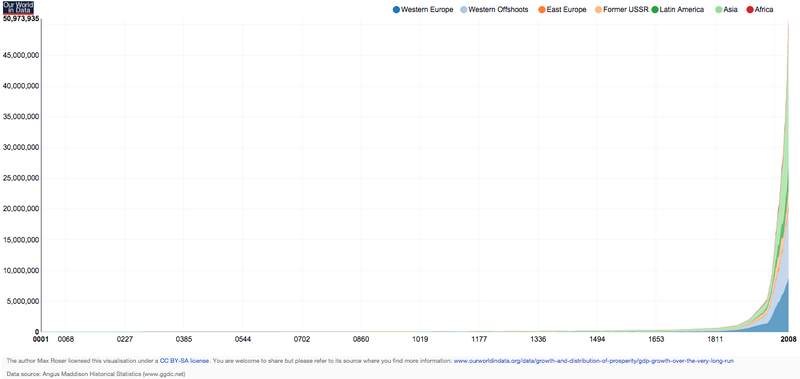
For most of human existence, our species was dirt poor. But that has changed rapidly since the 19th century: The world’s gross domestic product has spiked in a way that’s simply unprecedented in human history. The key factors here are the Scientific Revolution, the Enlightenment, the Industrial Revolution, and capitalism. These four transformations created and spread new ideas and technologies — modern medicine and electricity, for example — that allowed humanity to grow rich and healthy in a way that our distant ancestors simply couldn’t dream of.
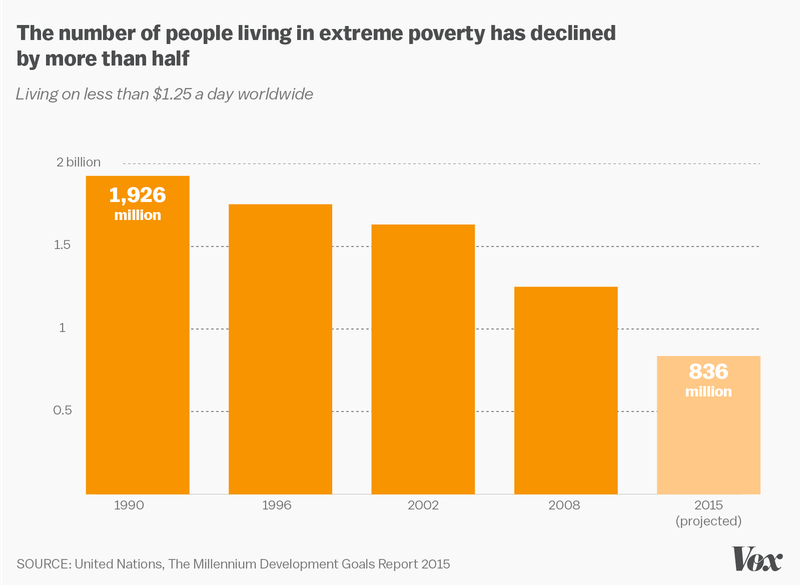
Economic growth hasn’t just benefited wealthy countries. Between 1990 and 2015, about 1.1 billion people have been lifted out of extreme poverty (defined as living on $1.25 a day). That means that in just the past 25 years, a full seventh of humanity has been saved from terrible want. A lot of that came from India and especially China, huge countries that experienced rapid growth in the past several decades. Much of sub-Saharan Africa is still mired in serious poverty. But the fact that the worldwide gains are concentrated in a few places doesn’t make them any less worthy of celebration. If what we care about is minimizing suffering in the world, then it shouldn’t matter what country the billion-plus people saved from poverty come from.
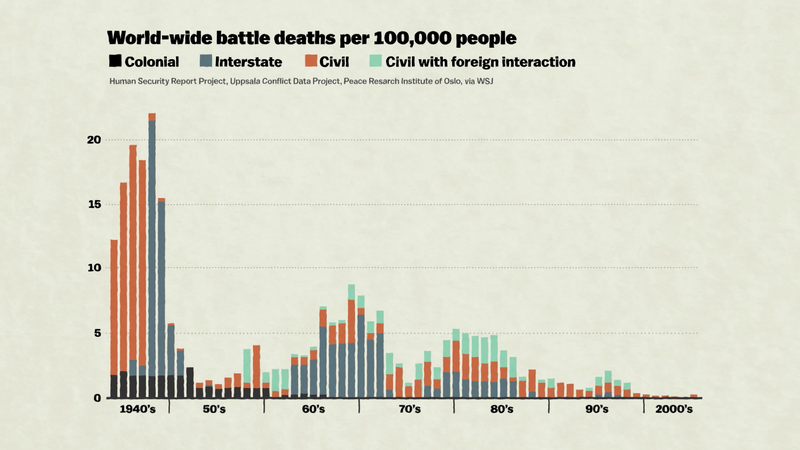
The modern world also birthed horrors — specifically, industrialized killing in the two world wars. But a wonderful thing has happened since then: Deaths from war have been in free fall. The percentage of the global population killed in wars has declined tremendously, owing in large part to the fact that major nuclear armed powers (like the US and Russia) have refrained from going to war. War isn’t over, obviously, but we’ve managed to contain it — safeguarding humanity’s gains from economic growth and scientific innovation.
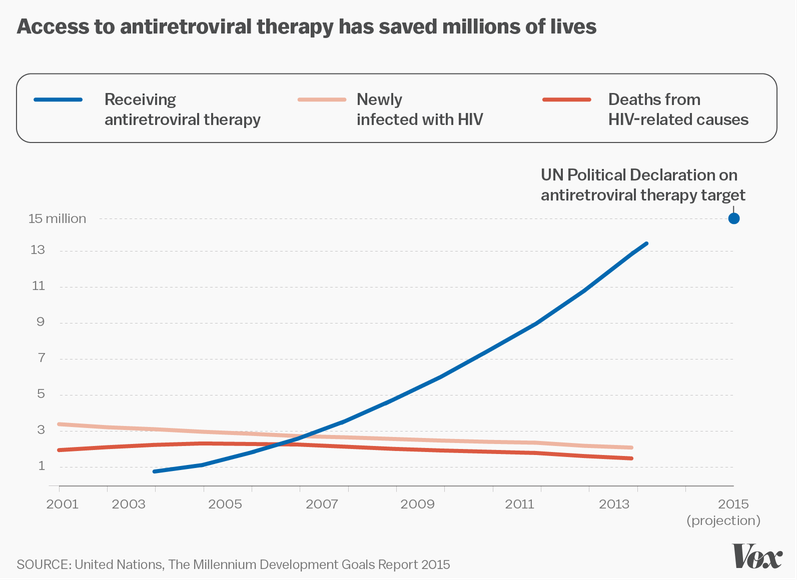
In the past 15 years, we’ve made serious progress in the fight against the HIV/AIDS epidemic. Between 2000 and 2013, documented new cases of HIV infection fell by 40 percent, and deaths from AIDS-related causes fell by 35 percent (from a peak in 2005). That’s in large part because there’s been a concerted global effort to spread the medication necessary to combat the plague. Programs like the President’s Emergency Plan for AIDS Relief (PEPFAR) have done an extraordinary job of getting impoverished people the treatment and assistance they need.
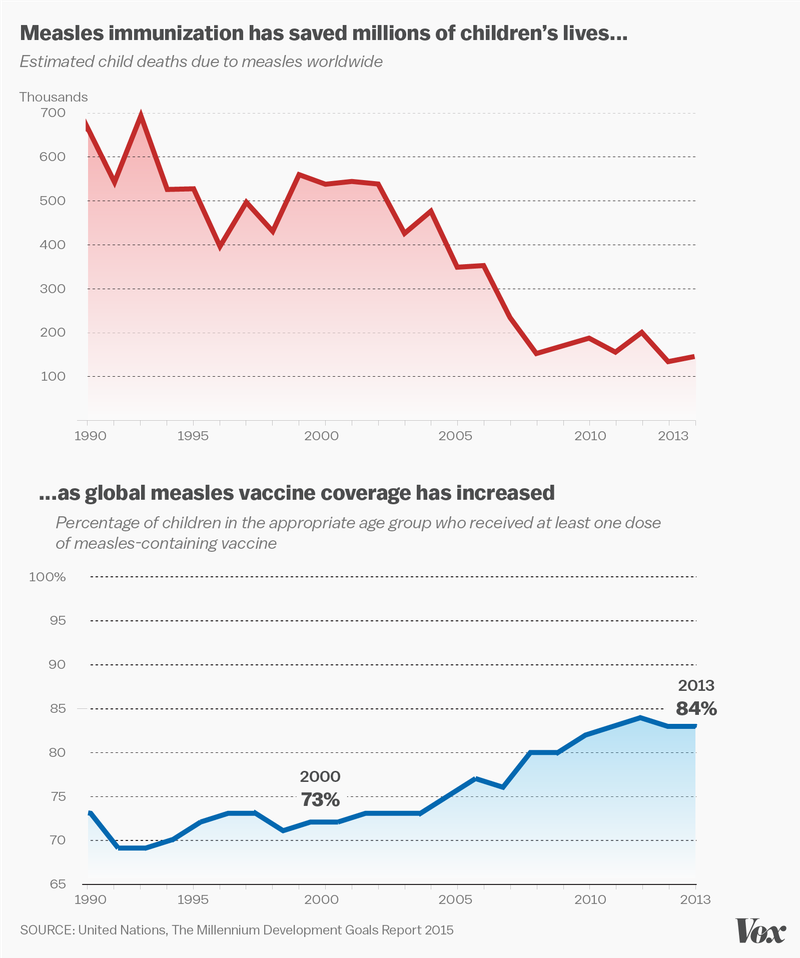
HIV/AIDS isn’t the only disease being beaten back. As the above chart shows, the global measles immunization campaign has been extraordinarily effective — saving the lives of an estimated 15.6 million people between 2000 and 2015. Deaths from malaria declined by 58 percent globally during the same period. Tuberculosis mortality has fallen by 43 percent since 1990. These diseases, all major killers in the developing world, are on the retreat — due to both local and international efforts to combat them.
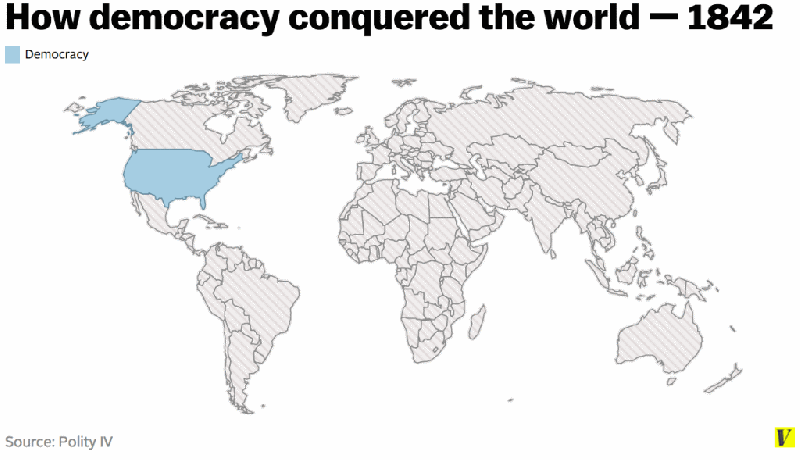
The spread of democracy is a critical part of this whole story. The American and French Revolutions marked the beginning of its global rise, but it wasn’t until the Cold War ended that democracy became the most popular form of government on Earth. The ramifications of democracy’s spread have been enormous: Democratic governments have never (or almost never) gone to war with each other, and are significantly less likely to slaughter their own people. Democracy has also put pressure on political leaders to keep their citizens happy, helping spread the gains from economic growth and technology from the wealthy to most of the world’s population. And that’s to say nothing of democracy’s inherent benefits (like giving people the right to choose their own governments).
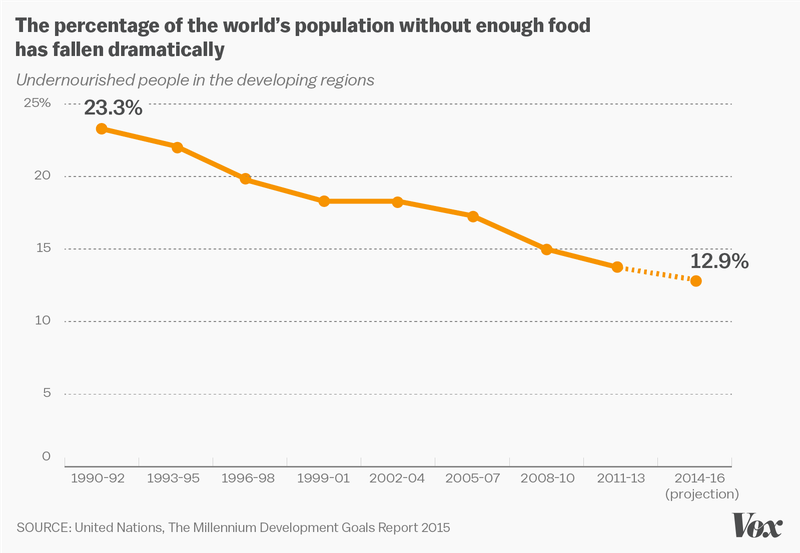
One of the benefits of the world’s growing wealth is that more people can afford food. From 1990 to 1992, 991 million people in the developing world were undernourished — meaning food-deprived — by the UN’s numbers. Today, that figure is 780 million. That’s a decline of more than 20 percent in the parts of the world where, in the past centuries, people have suffered the most from want of adequate food.
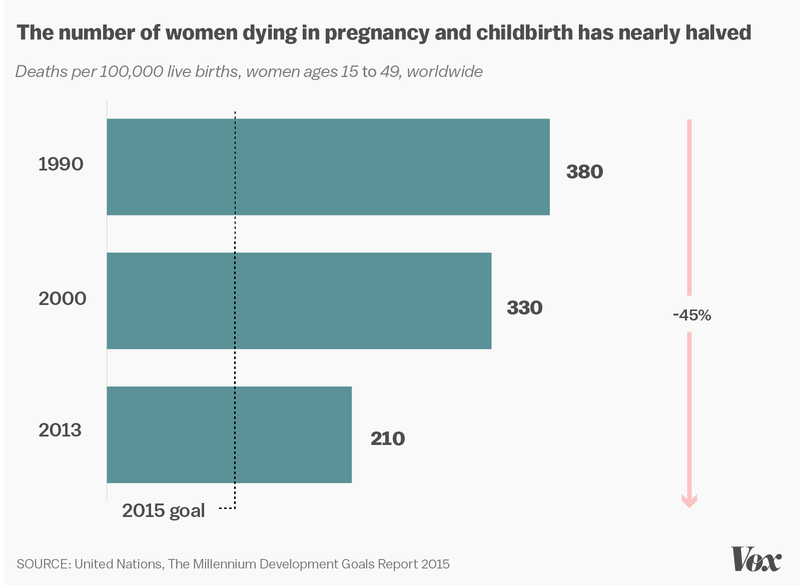
Until the advent of modern medicine, shocking percentages of women died in pregnancy and childbirth. The spread of techniques to address leading maternal killers, like hemorrhage and infection, has done wonders: Since 1990, the global rate of maternal mortality (death of a mother during pregnancy or within 42 days of its end) has gone down by a staggering 45 percent.
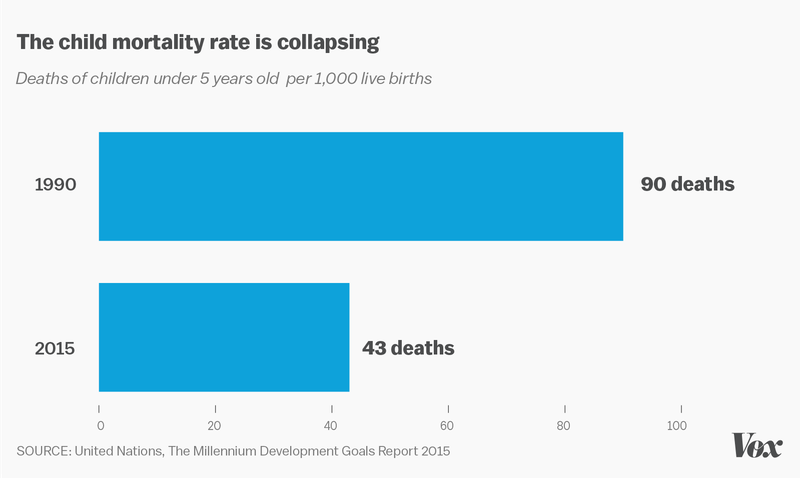
If you were born 400 years ago, the odds of you living past age 5 were terrifyingly low. Nowadays, the incidence of child mortality has plummeted, owing largely to improved access to health care and food. This is one of the key reasons life expectancy is so much higher than it used to be: The fewer deaths there are at a young age, the higher the average length of a human life from birth will be.
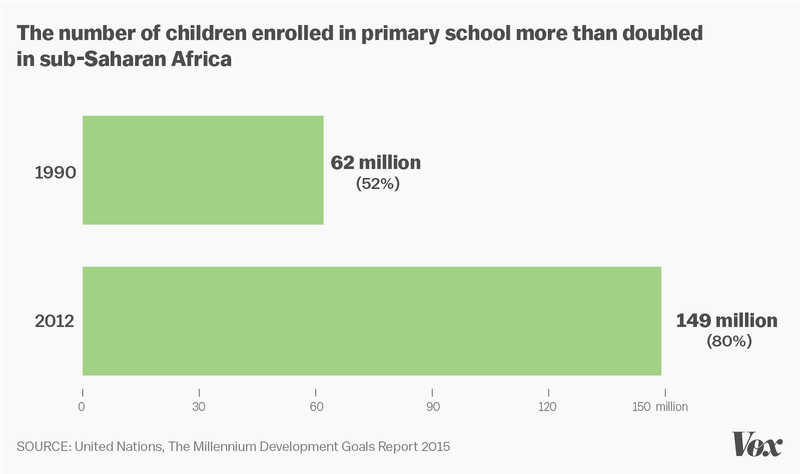
At the same time that more children are living to be old enough to get an education, opportunities for schooling have never been greater. Ninety-one percent of primary school-age kids worldwide are enrolled. Even in sub-Saharan Africa, the region with by far the worst primary school enrollment numbers, recent improvements have been nothing short of astonishing. In 1990, 52 percent of school-age kids in the region were enrolled. By 2012, that number had jumped to 80 percent.
7 Graphs That Show Which Climate Records Were Broken In 2014

The state of the world’s climate is complex enough that it takes 413 scientists from 58 countries half a year to completely summarize a year’s worth of data.
And 2014 was a doozy.
According to the the American Meteorological Society and NOAA, the “State of the Climate in 2014″ report, several markers measuring the earth’s climatic trends set historical records. This is the 25th year that scientists have provided this report, and it was full of hundreds of pages of detailed atmospheric and oceanic summaries of what’s happening to our air, land, and water.
“The year 2014 was forecast to be a warm year, and it was by all accounts a very warm year, in fact record warm according to four independent observational datasets,” the report said. The reason: “the radiative forcing by long-lived greenhouse gases continued to increase, owing to rising levels of carbon dioxide, methane, nitrous oxide, and other radiatively active trace gases.”
The world’s experts know that climate change is happening, and why, and provide reports like these every year spelling out the impacts in excruciating detail.
“The variety of indicators shows us how our climate is changing, not just in temperature but from the depths of the oceans to the outer atmosphere,” said Thomas R. Karl, director of NOAA’s National Centers for Environmental Information.
For those without the time to peruse nearly 300 pages of scientific summaries, here are seven records that fell in 2014.
Heat

CREDIT: NOAA/BAMS
Though the world knew this back in January thanks to NOAA data, the report confirmed, and elaborated upon, the certainty around the record broken by 2014 as the hottest year on record.
With the glaring exception of the eastern North American continent, many countries – more than 20 – broke high temperature records last year. Much of Europe and Mexico had their hottest years, while Australia, Argentina, Uruguay, and much of Africa came close.
“Australia’s annual mean temperature anomaly, with respect to 1961-90, was +0.91°C, making 2014 the third warmest year for the country since national temperature records began in 1910,” the report said. The year before, 2013, was the hottest year on record.
With emissions continuing and El Nino coming on strong, it should not be a surprise that 2015 looks to easily break 2014’s global average surface temperature record.
Sea Levels
To convey the surreality of their findings, G.C. Johnson and A.R. Parsons, the authors of the Global Oceans section of the report used a tactic uncommon in climatology. Haikus. Haikus for sea level rise and rising temperatures.
Not quite El Niño,
North Oceans’ fluxes, warmth shift,
dance with weird weather.Seas warm, ice caps melt,
waters rise, sour, rains shift salt,
unceasing, worldwide.
Measuring average global sea level is fantastically complex stuff. Winds can move large volumes of water around, temperature shifts can make the ocean shrink in some places and not others, while the daily tides, currents, and other variables conspire together to sabotage an accurate reading. So experts use a variety of different measurements and data streams to get something accurate and useful. And it told them that 2014 broke another sea level record.

CREDIT: BASM
“Owing to both ocean warming and land ice melt contributions, global mean sea level in 2014 was also record high and 67 mm greater than the 1993 annual mean, when satellite altimetry measurements began,” the report said.
Sea levels do not rise when icebergs or ice sheets floating in them melt – the water has already been displaced. Melting land ice does make sea levels rise, and this is the cause of sea level rise that most people know. However, the heat being pumped into the oceans from the greenhouse effect not only increases the temperature, it also causes the water to expand, which makes sea levels rise.
Hot Days, Warm Nights

CREDIT: NOAA/BAMS
“The year 2014 experienced a relatively large number of warm days,” the report said. The worldwide anomaly was the midwestern United States, which had a steady flow of Arctic cold keeping things chilly. Similarly, the world saw more warm nights and fewer cool nights outside of the Midwest.
Most of Europe had excessively large numbers of hot days and nights – daily maxima and minima. Several countries set records for warmest annual values.
“These continuous warm anomalies contributed to 2014 seeing the largest frequency of warm days and nights on record: on a continental average over a quarter of days (and nights) had temperatures in the warmest 10% of the climatological (1961-90) temperature distribution,” the report said.
The winter minimum in most of Alaska was also the warmest on record, which helped it break its regional heat record.
Storms In Hot Water
“Across the major tropical cyclone basins, 91 named storms were observed during 2014, above the 1981-2010 global average of 82,” the report said. “The Eastern/Central Pacific and South Indian Ocean basins experienced significantly above-normal activity in 2014; all other basins were either at or below normal.”
By many accounts, however, 2014 was a weak year for tropical cyclones, especially compared to the large number of strong storms in 2013. But the strong cyclones of 2014 were often extremely powerful.
Of the 91 named storms, seven became Category 5 systems: Marie and Genevieve, Cyclone Gillian, and then Super Typhoons Halong, Vongfong, Nuri, and Hagupit.
“The rate of typhoons that reached super typhoon status in 2014 was 67%, exceeding the previous record rate of 58% in 1970,” the report noted. Usually, only 23 percent of normal typhoons can hit super typhoon intensity each year.

CREDIT: BAMS
One factor at play is extremely high ocean surface temperatures.
“But it was the oceans that drove the record global surface temperature in 2014,” the report said. “Although 2014 was largely ENSO-neutral [EL Niño Southern Oscillation], the globally averaged sea surface temperature (SST) was the highest on record.”
Disappearing glaciers
“In higher latitudes and at higher elevations, increased warming continued to be visible in the decline of glacier mass balance, increasing permafrost temperatures, and a deeper thawing layer in seasonally frozen soil,” the report said. This was particularly dramatic in Greenland. Warm temperatures melt ice faster than snowfall can replenish it, and darker melt pools on the top of the glaciers absorb more energy from the sun than frozen white ice.
This has been going on for decades, and the rate has been accelerating:

The World Glacier Monitoring Service received preliminary data from Argentina, Austria, Chile, China, France, Italy, Kazakhstan, Kyrgyzstan, Nepal, Norway, Russia, Sweden, and the United States. It indicated that for the 31st consecutive year, the world saw no “positive annual balances,” of the water stored by glaciers. Specifically, the earth saw the loss of 0.853 meters of water equivalent – “the equivalent depth of water resulting from snow or ice melt.”
Since 1980, that cumulative mass balance loss hit 16.8 meters in 2014.
Pollution
The report said carbon dioxide, methane, and nitrous oxide all hit record concentrations in the atmosphere last year, as they have for essentially each year beforehand.
“Carbon dioxide increased by 1.9 ppm [parts per million] to reach a globally averaged value of 397.2 ppm for 2014,” the abstract began. “Altogether, 5 major and 15 minor greenhouse gases contributed 2.94 W/m² of direct radiative forcing, which is 36% greater than their contributions just a quarter century ago.”

CREDIT: BAMS
Some climate watchers are familiar with the Keeling Curve, which has plotted the carbon dioxide concentration readings taken from the Mauna Loa Observatory in Hawaii since 1958. In 2013, the tracker passed above 400 ppm for the first time in recorded history, and each year since, more days have been spent above that symbolic number.
Using other measurements to supplement the data, the report estimated that the 2014 global average was 397.2 ppm of CO2 in the atmosphere, a 1.9 ppm bump from 2013. This year, the number will continue its inexorable climb, unless global emissions slow significantly.
One graph unknown to most is the methane concentration graph, let alone the nitrous oxide graph. Those, according to the report, show a similar upward sweep. The CFC graph at the bottom alone displays a slow decline in atmospheric concentrations because the world came together more than 25 years ago to address the hole in the ozone layer CFCs were creating, and agreed on the Montreal Protocol. This limited CFCs’ use in aerosols and other products. They were largely replaced, however, by HFCs, which are also extremely potent greenhouse gases.
The CFC graph shows what a successful emissions reduction regime might look like for the other greenhouse gases.
Seaweed That Tastes Like Bacon Could Be Great For The Environment
CREDIT: Stephen Ward, OSU Extension and Experiment Station Communications
Last week, researchers at Oregon State University announced that they had successfully patented a new strain of red marine algae, known as dulse, that grows extremely quickly and could serve as an excellent source of plant-based protein.
It also, according to researchers, tastes exactly like bacon when it’s fried.
That last fact was enough to set the food world into a tailspin, inspiring a flurry of media coverage touting dulse as a ” super seaweed,” ” the holy grail of seafood,” and ” the unicorn.”
Finding a nutrient-rich alternative to bacon is certainly good news for health-conscious eaters – but an increase in seaweed farming across the United States would be really good news for environmentalists, too.
I think we were at the right place at the right time, where there’s more and more interest in using aquatic plants for human food
Charlie Yarish, a professor of ecology and evolutionary biology at the University of Connecticut, has been a seaweed farmer for decades, cultivating strains of kelp in the coastal waters of Connecticut and Long Island. And apart from being a tasty product with a robust international industry ( 25 million tons of seaweed are harvested annually around the world), Yarish thinks seaweed is a particularly exciting crop because of its ability to extract nutrients from aquatic ecosystems. Basically, seaweed doesn’t just grow in the coastal waters that humans are pumping full of pollutants – it thrives in those environments.
“You’re dealing with a crop that doesn’t require fresh water, it does not require arable land,” Yarish told ThinkProgress. “We’re starting to see in western cultures there are some very interesting attributes of seaweed that fit our needs. One of the major problems that coastal managers have has to do with managing nutrients.”
In 2010, 39 percent of the United States’ population lived along the coastline, bringing with them industry – like agriculture – that pumps coastal waters full of nutrients like nitrogen and phosphorous and contaminants like mercury and lead.
Nitrogen, primarily from agricultural fertilizers, is an especially common nutrient in coastal waterways, but an overabundance of nitrogen in coastal waters encourages phytoplankton growth and algal blooms, which deplete oxygen from marine ecosystems. Unconstrained nutrient runoff from agricultural areas can lead to coastal dead zones – areas completely void of oxygen – that can rob communities of economic gains from fishing and shellfish harvesting.
“That’s just not good for the environment,” Yarish says of marine dead zones. “Economic values decline for coastal communities and the very resource that people want to live by is starting to be degraded.”
But seaweed farming can help reverse an imbalance in nutrients through bioextraction – the process of taking up nitrogen and other nutrients and converting them to living tissue (in the form of edible seaweed). It’s what’s known as an ecosystem service, where living organisms provide a beneficial service to the environment.
“If you use the right seaweeds, you can actually start extracting nutrients,” Yarish said. “In areas where you have excess nutrients, that’s an opportunity. We’re doing an ecosystem service, and creating crops.”
The right kind of seaweed is a tricky question – and where the potential for dulse to become a sustainable substitute for bacon both succeeds and falters. All seaweed, according to Yarish, extracts nutrients as it grows. The problem is a matter of scale.
“There are limitations on how much you can produce,” Yarish said. “A kelp farm can produce far more biomass than Palmaria [the scientific name for dulse].”
You’re dealing with a crop that doesn’t require fresh water, it does not require arable land
Dulse is a red, lettuce-like algae that grows naturally in the coastal waters of the Pacific and Atlantic. For 15 years, Chris Langdon, an aquaculture researcher at Oregon State University’s Hatfield Marine Science Center in Newport, Oregon, has studied dulse, trying to figure out a way to make the nutritious algae grow quickly enough to become commercially viable feed for abalone, a type of edible sea snail. In 2004, he obtained a patent for a particularly fast-growing strain that can double its weight in just 10 days. But a year and a half ago, Chuck Toombs, a business professor at Oregon State University suggested that Langdon might want to stop trying to grow dulse for abalone, and start growing it for humans.
“I think we were at the right place at the right time, where there’s more and more interest in using aquatic plants for human food,” Michael Morrissey, director of Oregon State University’s Food Innovation Center, told ThinkProgress.
Langdon, along with Morrissey and others at the Food Innovation Center, reached a historic moment with dulse in January, when they were able to have it declared a specialty crop by the Oregon State Department of Agriculture – something that has never happened for a seafood. Under the specialty crop status, the team could apply for a grant to expand their dulse research, whittling down a list of over a hundred potential dulse products to two finalists – a cracker and a salad dressing – that they hope will hit retail shelves in the fall.
Unlike the kelp that Yarish grows along the Atlantic coastline, Langdon and his colleagues grow dulse in cultured tanks of seawater. That allows them to fine-tune the nutrient content of the water and grow dulse year round, but it also constrains their ability to scale their dulse operation to a commercially-viable size. But, if Western palates find the smoky taste of dulse appealing, there’s no reason that dulse couldn’t be integrated into coastal seaweed farming schemes – improving the diversity of seaweed farms across the United States. Maine Coast Sea Vegetables – a seaweed farming company that produces about 100,000 pounds of sea vegetables annually – already grows dulse in Maine’s coastal waters as part of its operation.
“If they got something that tastes like bacon, they added value for that particular red seaweed,” Yarish said. “It’s all part of the equation. Diversity is important, diversity harbors unique attributes of genomes that can respond to environmental pressures.”
Besides nutrient runoff, ocean acidification is another environmental pressure that’s expected to alter marine ecosystems in the future. As the ocean begins to absorb more and more of the carbon dioxide that humans are putting into the atmosphere, the pH of the water is expected to decrease, making the world’s oceans more acidic. For organisms like shellfish, that could be a problem, because acidic waters means shellfish have to work harder to produce their shells, leaving them with less energy to fight disease or find food.
But like excess nutrients, Yarish said, seaweed has also shown an ability to thrive in waters with greater concentrations of carbon dioxide.
“Algae are the winners when it comes to ocean acidification,” he said. “They have the ability to extract more CO2 out of the water, and therefore lowering the pH of that water.”
To Morrissey, finding a hardy strain of seaweed that has the potential to adapt to the changing environment is an exciting discovery for a food system that is grappling with how to sustainably feed the more than nine billion humans that are expected to live on earth by 2050.
“Seaweeds or aquatic plants have been in the background, but I think they need to come to the foreground and be present as an important component in this mix,” he said. “They are fairly easy to grow, you can grow them in terms of production of biomass, its some of the fastest growing food on the planet, and people need to look at that and take advantage of it.”
These “Free Spirit Spheres” Would Make the Most Amazing Getaways for Nature Lovers
Posted Jul 04, by Brandon Siewert
When it comes to camping, there are outdoorsmen, and there are people that love the outdoors. The latter have a passion for nature, but appreciate everyday comforts and prefer not to endure its elements. The former on the other hand, welcome poor conditions with open arms, seeing them as just another part of the experience.
Then there’s the third group of people – those that aren’t passionate about the outdoors per se, but desperately need a retreat from the hubbub of their lives. For those people, and many others simply looking for a quiet getaway, there’s Free Spirit Spheres.
h/t Free Spirit Spheres
These Twin Designers Just Invented Plant Pots That Actually Grow When The Plant Grows
Using the Japanese art of origami, London-based twin designers, Bike and Begum Ayaskan of Studio Ayaskan, designed a plant pot – fittingly named, “Growth” – that geniusly expands as a plant’s root system grows.


